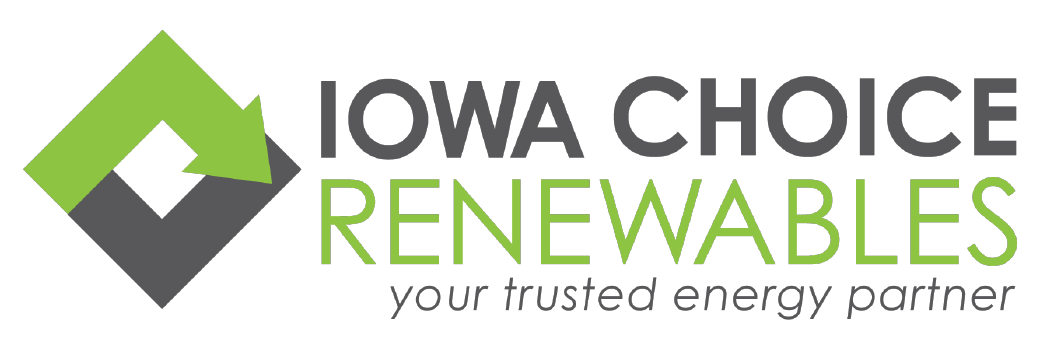Distributed Generation
Planning for a home distributed generation or small-scale renewable energy system is a multi-step process. Click on each step below to expand and read all of the important information before purchasing equipment.
Give us a call FIRST. We're your trusted energy partner. Your co-op is part of Iowa Choice Renewables, a group of rural electric cooperatives in Iowa that were established to provide honest and reliable renewable energy resources. Personal solar arrays can also be purchased through Iowa Choice Renewables (ICR). We can help you understand the interconnection requirements and give you credible resources and information. With any system, maintaining the safety and reliability of the overall power grid is of the utmost priority. We’ll walk you through a number of safety precautions that must be considered.
To get an idea of the possible cost and payback of installing a solar array at your home of business, visit our solar calculator.

Check out these energy saving tips. Installing energy efficient products in your home, such as LED light bulbs instead of incandescents, in advance of installing a renewable energy system can save you money by reducing your overall energy usage which can reduce the size of the system you'll need to meet your needs.
Request an energy audit. Give us a call and we'd be happy to schedule an energy audit with you. We'll walk with you through your home and analyze what could be using the most energy and suggest ways you can make your home more energy efficient.
Research local codes. Your county or community likely has specific codes and regulations you have to follow if you decide to install a system.
Complete additional research. The Iowa Utilities Board has developed an Informational Guide for On-Site Generation (Distributed Generation) to help consumers who are considering the installation of electric generation on their property. The Iowa Energy Center, who's mission includes "providing Iowans with reliable, objective information on energy and efficiency options," created a helpful publication called the Solar PV Energy Guide.
The Cooperative's Responsibilities
A written agreement between the cooperative and the member-consumer is developed (see Step 5) to ensure proper communication and protections are in place prior to connection of the facility to the grid. Consideration must also be given to established requirements for installation, maintenance, metering, switching and liability insurance.
The Member's Responsibilities
The general requirements for a member-consumer to install and interconnect wind or solar generation include paying for any interconnection devices that are necessary to protect the safety of the cooperative representatives and to maintain the integrity of the delivery system. The member-consumer is also expected to carry liability insurance. Individuals must also pay for the necessary metering equipment used to measure kilowatt-hours (kWhs) delivered back to the grid by the member-consumer.
With the passage of House File 2301 by the Iowa Legislature, member-owners installing renewable energy systems must provide notice to their cooperative utilities in writing 30 days before the generators are installed.
Safety hazards result if member-owners install alternative generating sources, such as solar panels or small wind turbines, without notifying the cooperative of that installation. Should there be a power outage requiring work on cooperative electric lines, linemen may be unaware of the additional connected generation and think the line is dead. Linemen could be injured by power feeding back onto the line from the member-owner's alternative energy sources.
When contacted about new alternative generation that will be installed, the cooperative will advise member-owners about devices needed at the interconnection point that will keep power from flowing back onto the grid in maintenance or emergency situations.
Interconnecting with Midland Power Cooperative
For more information on distributed generation, refer to Midland Power Cooperative's Cogeneration and Small Power Production Tariff.
For information on payments for excess power you might generate, refer to 2024 Information for Co-Generators.
For Midland Power's Corn Belt territory for members in the map's blue area:
Grundy County; Hamilton County Townships of Independence, Liberty, Lincoln, Lyon, Rose Grove, Scott & Williams; Hardin County; Humboldt County; Kossuth County; Marshall County; Pocahontas County; Story County Townships of Howard, Lincoln, Milford, Richland, Sherman & Warren; Wright County.
Level 1 Application (20 kVA or less)
Level 2-4 Application (10 MVA or less)
For Midland Power's CIPCO territory for members in map's orange area:
Boone County; Calhoun County; Dallas County; Greene County; Guthrie County; Hamilton County Townships of Marion or Webster; Polk County; Story County Townships of Franklin, Palestine & Washington; Webster County.
Level 1 Application (20 kVA or less)
Level 2-4 Application (10 MVA or less)
For members in the gray area of the map, contact us with the service address to find out which application form needs to be completed. This is for the following locations:
Hamilton County Townships of Clear Lake; Ellsworth; or Hamilton; and the Story County Township of Lafayette.
.png)
